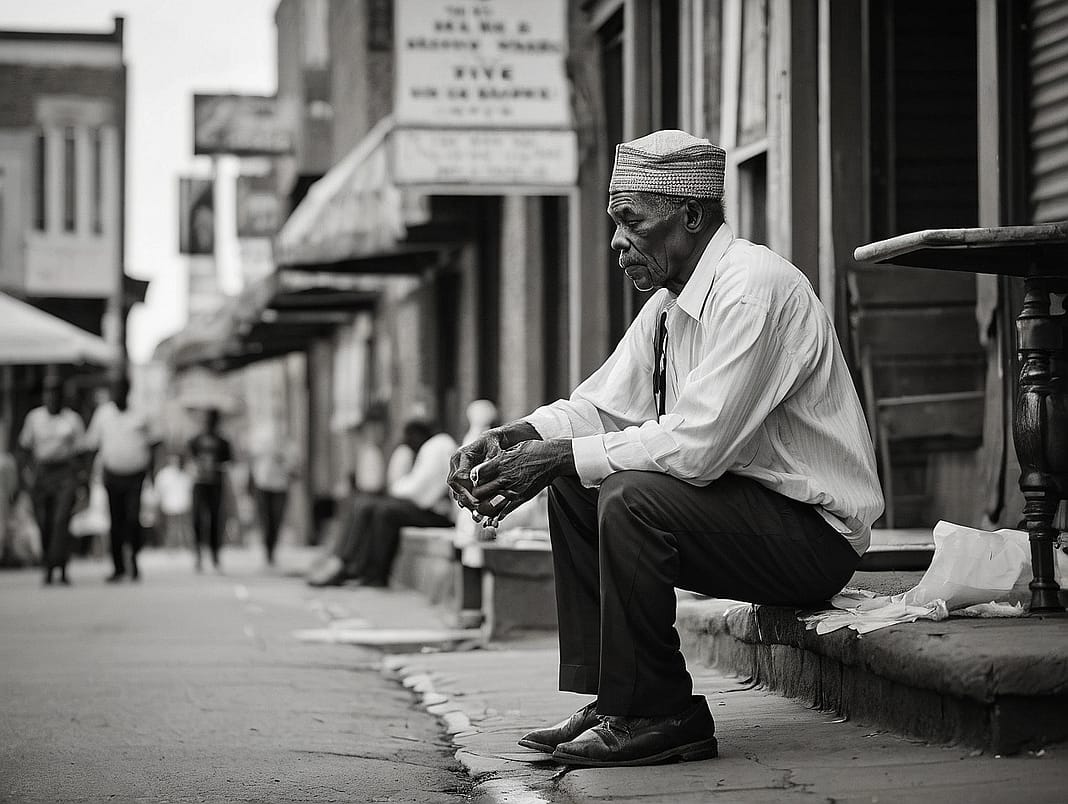There was a time when the heart of Louisville beat on Old Walnut Street, where the hum of African American life rose like a hymn, grounded in struggle but lifted by dreams. The street stretched wide and deep, a spine of resilience running through a community that had been pushed out, set aside, but never silenced. It was a place where the fragrance of Black enterprise and culture lingered in the air like sweet tobacco and warm bread, a place where the people knew that survival wasn’t enough—they wanted to thrive.
It was here that grandmothers dressed in their Sunday best could be found, steady hands running over velvet hats as they exchanged nods with men who owned their own businesses, who held keys to doors built by their own labor. It was here that Black doctors and lawyers tended to their people, their offices perched high above streets pulsing with jazz, rhythm, and blues. Walnut Street was where everything Black Louisville needed could be found—from insurance policies to the laughter of a man selling newspapers, calling out headlines with a grin that betrayed the seriousness of the times.
You see, it wasn’t just a street. It was an idea, a testament to what happens when a people denied dignity build it for themselves.
A Place Where Dreams Weren’t Deferred
There’s a question on the lips of many today, perhaps a whispered wonder of how such a place came to be: How did Walnut Street thrive during segregation?
The answer is as much a reflection of human will as it is of circumstance. The weight of segregation forced Black people into isolation, yes, but in that isolation, something beautiful bloomed. When the city refused them spaces, they created their own. They didn’t wait for permission. Instead, they pulled their resources and talents together, shaping Walnut Street into a sanctuary of ownership and pride.
And pride, after all, is a peculiar thing. It’s both fuel and refuge. On Walnut Street, it drove African Americans to take up the reins of economic power, forming institutions that allowed them to control their own narratives. The Mammoth Life and Accident Insurance Company became one of the largest Black-owned insurers in the nation, built not on the desire for excess, but on the need for stability in a world determined to make their lives precarious. It was more than just a business—it was a bulwark against a society that left them vulnerable at every turn.
But even more than enterprise, Walnut Street was a place of self-expression. There are those who wonder today, Why is Walnut Street important in African American culture? The answer lives in the way that music—soul-stirring, gut-wrenching, feet-tapping music—poured out of clubs like the Lyric and Palace Theatres. This wasn’t just entertainment; it was communion. Billie Holiday’s voice floated over those streets like a balm, Duke Ellington’s melodies taught people to dream, and the beats of a hundred jazz bands swelled and collapsed like the tide, carving out space for joy even in the midst of hardship.
Walnut Street was Harlem in Kentucky, a testament to Black creativity and ingenuity, a place where Blackness wasn’t something to apologize for but something to wear proudly, like a well-tailored suit.
A Symphony Silenced
And yet, all symphonies come to an end. The question that haunts us now is simple: What happened to Walnut Street?
In the 1960s, urban renewal swept through America’s cities like a cold wind, and with it came the wrecking balls that destroyed the homes, businesses, and lives carefully crafted along Walnut Street. The city called it progress. But for the African American community, it felt like erasure. Walnut Street, this sacred space where Black men and women had fought so hard to carve out a piece of dignity, was razed in the name of highways and new development. Some called it urban renewal; others, with a bitterness on their tongues, called it “urban removal.”
They came for the bricks and mortar, yes, but they took more than buildings. They fractured the heart of Black Louisville. The businesses that had been the backbone of the community—gone. The music that had flowed from every corner—muted. The sense of ownership, the pride, the joy—uprooted.
But you see, history does not die just because the earth where it stood is paved over. There are still those who remember the hum of that street, the smell of fried fish on a Friday night, the laughter spilling out of the doors of corner shops, the dignity that lives in building something from nothing.
Remembering What Was Lost, Honoring What Remains
Today, the street has a different name—Muhammad Ali Boulevard. But the spirit of Old Walnut still whispers through its corners, carried by those who refuse to let the memory die. And as we walk those streets, we must ask ourselves: What does Walnut Street symbolize for African Americans today?
It stands as a reminder. A reminder that no matter what is taken, the spirit of a people cannot be bulldozed. It symbolizes not just the wealth and enterprise that once flourished, but the resilience of a community that, even when its buildings were flattened, refused to be.
There is talk now of preservation, of remembering, of a Louisville African American Heritage Center that seeks to give voice to what once was. And though those efforts are necessary, they are not enough. What Walnut Street teaches us is that history is not something that lives only in museums. It must be carried in the hearts of those who understand its significance, those who refuse to forget.
Building Again
We live now in a time when the question of Black ownership, Black pride, and Black survival has returned with urgency. The world shifts again under the feet of our communities, and we are left wondering: Can we build something like Walnut Street once more?
Perhaps. But the real question is whether we are willing to remember the lessons of the past. Are we willing to own our spaces, to create new sanctuaries of culture and enterprise that cannot be taken so easily? Are we willing to fight not just for survival, but for dignity, for joy, for something that is ours?
Old Walnut Street remains an enduring symbol of African American resilience, enterprise, and culture in Louisville. Although much of the physical infrastructure has been lost, the street’s legacy continues to inspire efforts to celebrate African American history and culture in the city. The community that once thrived on Walnut Street left a lasting impact on Louisville, helping shape the city’s identity and contributing to the broader African American cultural renaissance of the 20th century.
This vibrant neighborhood, with its deep connections to jazz, civil rights, and economic self-determination, serves as a powerful reminder of the importance of African American spaces in shaping local and national culture.
Let us build again.
Discover more from The Reasoned Journey
Subscribe to get the latest posts sent to your email.


